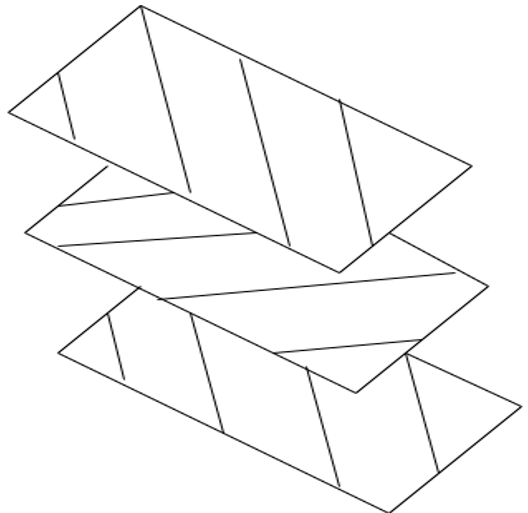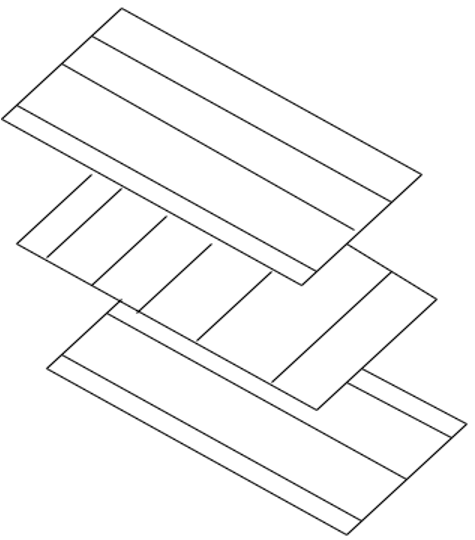This set of Composite Materials Multiple Choice Questions & Answers (MCQs) focuses on “Laminated Structure”.
1. Which laminate has the fiber orientation angles same in all laminas?
a) Angle-ply laminate
b) Symmetric laminate
c) Unidirectional laminate
d) Cross-ply laminate
View Answer
Explanation: The fiber orientation angles of the laminas are the same in unidirectional laminate. For example, in unidirectional 0° laminates, θ=0° in all laminates.
2. Identify the laminate given below:

a) Symmetric laminate
b) Unidirectional laminate
c) Angle-ply laminate
d) Cross-ply laminate
View Answer
Explanation: The fiber orientation angles in alternate laminas in angle ply laminates are the same. The stacking sequence is in the form /θ/-θ/θ/-θ/ where θ≠ 0° or 90°.
3. Identify the laminate given below.

a) Cross-ply laminate
b) Symmetric laminate
c) Unidirectional laminate
d) Angle-ply laminate
View Answer
Explanation: A Cross-ply laminate contains a number of laminas, each with a fiber orientation angle of either 0° or 90°. The stacking sequences are in the form /0°/90°/0°/90°/.
4. Which laminate has the ply orientation anti-symmetric about the centerline of the laminate?
a) Unsymmetric laminate
b) Antisymmetric laminate
c) Quasi-isotropic laminate
d) Angle-ply laminate
View Answer
Explanation: The ply orientation in the Antisymmetric laminate is anti-symmetric about the centerline of the laminate. There is a ply of fiber orientation angle –θ for each ply of fiber orientation angle θ above the midplane with identical material and thickness at an equal distance below the midplane.
5. There is no symmetry or anti-symmetry in unsymmetric laminates.
a) True
b) False
View Answer
Explanation: An unsymmetric laminate does not have both geometric and material symmetries with respect to the mid-surface. Examples of such laminates are 0/θ/-θ/90 and 0/0/0/90/90/90.
6. Quasi-isotropic laminates are made of three or more laminas with equal angles between each adjacent lamina.
a) True
b) False
View Answer
Explanation: Quasi-isotropic laminates are made of three or more laminas of identical material and thickness with equal angles between each adjacent lamina. Examples of stacking sequence combinations of some simple quasi-isotropic laminates are [+60/0/-60], [+45/0/-45/90], [0/+60/-60] and [0/+45 /-45/90].
7. Which is not a step in the Lamination theory?
a) Calculation of thickness of the laminate
b) Calculation of in-plane stresses
c) Calculation of in-plane strains
d) Calculation of stiffness matrices
View Answer
Explanation: The Lamination theory is used for determining or calculating stresses and strains in each lamina of a laminated structure. The first step in the lamination theory is the calculation of stiffness matrices for the laminate which is followed by the calculation of midplane strains and curvatures for the laminate, the calculation of in-plane strains for each lamina and the calculation of in-plane stresses in each lamina.
8. What is the laminate with normal shear stress-strain coupling equals to zero called?
a) Neutral laminate
b) Stabilized laminate
c) Balanced laminate
d) Zero coupling laminate
View Answer
Explanation: The normal stress–shear strain coupling for the laminate is zero if for every lamina of +θ orientation there is a lamina of –θ orientation with identical thickness and material. The locations of these 2 laminas are arbitrary.
9. The mechanical strains are due to free expansion caused by temperature variations.
a) True
b) False
View Answer
Explanation: It is the thermal strains that evolve due to free expansion caused by temperature variations. The mechanical strains are developed due to both thermal loads and applied loads. Thermal loads are produced due to restrictions imposed by various laminas against their free thermal expansion.
10. Moisture can also influence laminate strains.
a) True
b) False
View Answer
Explanation: In many composites, the moisture can also influence the laminate strains owing to volumetric contraction or expansion of the matrix. It is caused by moisture desorption or absorption.
11. Residual stresses may develop in laminates by temperature differences.
a) True
b) False
View Answer
Explanation: Significant residual stresses may develop owing to the thermal mismatch of various laminas during cooling a composite laminate from the curing temperature to room temperature. In some cases, these residual(curing) stresses may be sufficiently high to cause intralaminar cracks. Therefore, it is important to carefully consider them in the analysis of composite laminates.
Sanfoundry Global Education & Learning Series – Composite Materials.
To practice all areas of Composite Materials, here is complete set of 1000+ Multiple Choice Questions and Answers.
If you find a mistake in question / option / answer, kindly take a screenshot and email to [email protected]
